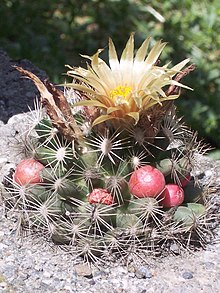| Pelecyphora missouriensis | |
|---|---|

| |
| Conservation status | |
 Least Concern (IUCN 3.1) | |
 Secure (NatureServe) | |
| Scientific classification | |
| Kingdom: | Plantae |
| Clade: | Tracheophytes |
| Clade: | Angiosperms |
| Clade: | Eudicots |
| Order: | Caryophyllales |
| Family: | Cactaceae |
| Subfamily: | Cactoideae |
| Genus: | Pelecyphora |
| Species: | P. missouriensis |
| Binomial name | |
| Pelecyphora missouriensis (Sweet) D.Aquino & Dan.Sánchez | |
| Synonyms | |
Synonymy
| |
Pelecyphora missouriensis, the Missouri foxtail cactus and formerly Coryphantha missouriensis, is a species of low-growing North American cacti.
Description
Pelecyphora missouriensis grows up to 30 centimetres (12 in) high and forms clumps to 3.8–30 centimetres (1.5–11.8 in) or greater in diameter. They are generally larger in the Southwest. The plants are primarily unbranched, except eastern populations that can be profusely branched. The warts are elongated and up to 18 millimeters long. There are 10 to 20 spines that are bright white, pale gray, or pale tan, weathering to gray or yellowish brown. The plant blooms in April to June, with flowers that are pale greenish yellow to yellow-green with midstripes of green or rose-pink to pale brown, flowers are 2.5 to 6.2 centimeters long and in diameter. The red fruits are 1 to 2 centimeters long.
Pelecyphora missouriensis has been extirpated from many of its historically known sites by introduced fire ants, suburban development, brush encroachment following fire suppression, and over-grazing.
Subspecies
There are two recognized subspecies.
Distribution
It is found in along the Missouri River in the tallgrass prairie and shortgrass Great Plains, from Texas to Montana and the Dakotas, and in the Rocky Mountains woodlands of Ponderosa pine (Pinus ponderosa), pinyon-juniper, and Gambel oak (Quercus gambelii) west of it. It is also native to the Southwestern United States in Idaho, Kansas,Arizona, New Mexico, and Utah and Mexico in the states of Coahuila and Nuevo León.
Taxonomy
It was first described in 1818 by Thomas Nuttall as Cactus mammillaris. The specific epithet missouriensis refers to the occurrence of the species near the Missouri River. However, this description was not valid (nom. illegal ICBN article 53.1), as the name was already given by Carl Linnaeus in 1753. Robert Sweet named the species Mammillaria missouriensis in 1826. In 1978, the species was reclassified as Escobaria missouriensis by David Richard Hunt. David Aquino & Daniel Sánchez moved the species to Pelecyphora based on phylogenetic studies in 2022. Further nomenclature synonyms are Cactus missouriensis (Sweet) Kuntze (1891), Mammillaria missouriensis Sweet ex K.Schum. (1898), Coryphantha missouriensis (Sweet) Britton & Rose (1913), Neobesseya missouriensis (Sweet) Britton & Rose (1923) and Neomammillaria missouriensis (Sweet) Britton & Rose ex Rydb. (1932).
References
- Heil, K.; Terry, M.; Corral-Díaz, R. (2017) . "Escobaria missouriensis". IUCN Red List of Threatened Species. 2017: e.T151844A121510797. doi:10.2305/IUCN.UK.2017-3.RLTS.T151844A121510797.en. Retrieved 5 November 2023.
- NatureServe (2023). "Escobaria missouriensis". Arlington, Virginia. Retrieved 28 December 2023.
- "Pelecyphora missouriensis (Sweet) D.Aquino & Dan.Sánchez". Plants of the World Online. Retrieved 2023-11-05.
- ^ Flora of North America, Missouri foxtail cactus Coryphantha missouriensis . accessed 4.4.2011
- NPIN_Escobaria missouriensis . accessed 4.4.2011
- United States Department of Agriculture plants profile, Escobaria missouriensis . accessed 4.4.2011
- Biota of North America Program, 2014 county distribution map
- Nuttall, Thomas (1818). The genera of North American plants, and a catalogue of the species, to the year 1817. Philadelphia: Printed for the author by D. Heartt. doi:10.5962/bhl.title.290.
- Sweet, Robert (1826). Sweet's Hortus britannicus: or a catalogue of plants cultivated in the gardens of Great Britain, arranged in natural orders. London: J. Ridgway. doi:10.5962/bhl.title.43792.
- Sánchez, Daniel; Vázquez-Benítez, Balbina; Vázquez-Sánchez, Monserrat; Aquino, David; Arias, Salvador (2022-01-21). "Phylogenetic relationships in Coryphantha and implications on Pelecyphora and Escobaria (Cacteae, Cactoideae, Cactaceae)". PhytoKeys. 188. Pensoft Publishers: 115–165. doi:10.3897/phytokeys.188.75739. ISSN 1314-2003. PMC 8799629.
External links
 Media related to Escobaria missouriensis at Wikimedia Commons
Media related to Escobaria missouriensis at Wikimedia Commons Data related to Pelecyphora missouriensis at Wikispecies
Data related to Pelecyphora missouriensis at Wikispecies- Flora of North America — Coryphantha missouriensis (Escobaria missouriensis)
- United States Department of Agriculture Plants Profile: Escobaria missouriensis
- Lady Bird Johnson Wildflower Center, University of Texas: Escobaria missouriensis (Missouri foxtail cactus)
| Taxon identifiers | |
|---|---|
| Escobaria missouriensis |
|
| Mammillaria missouriensis | |




